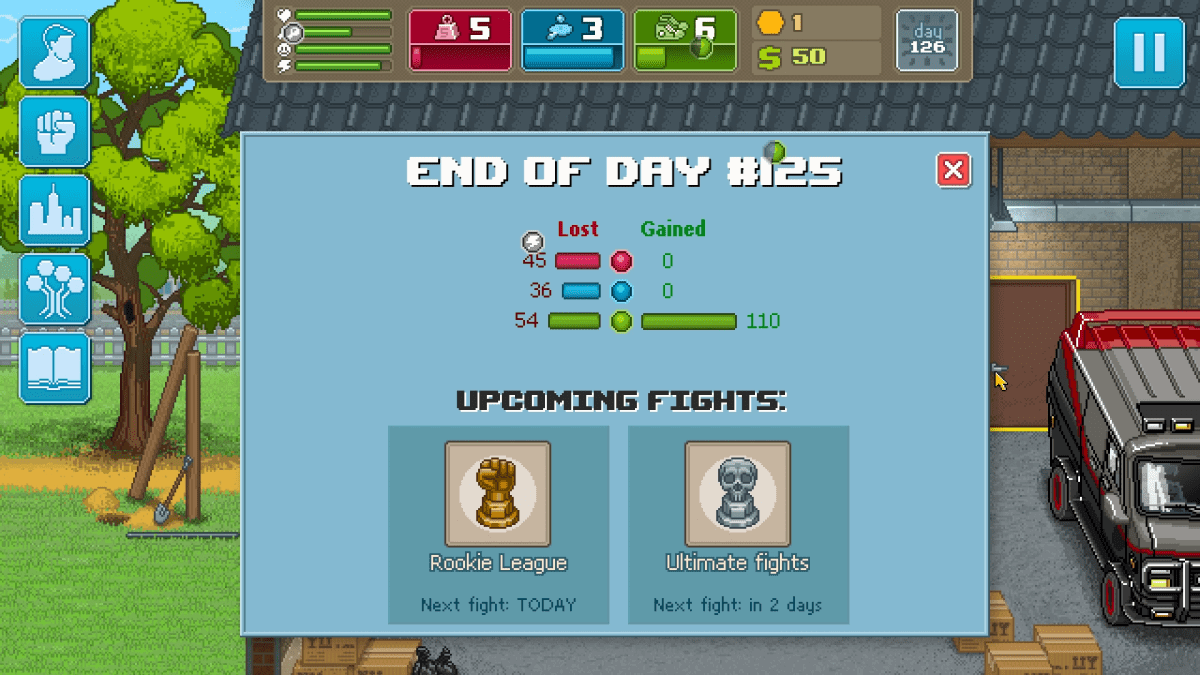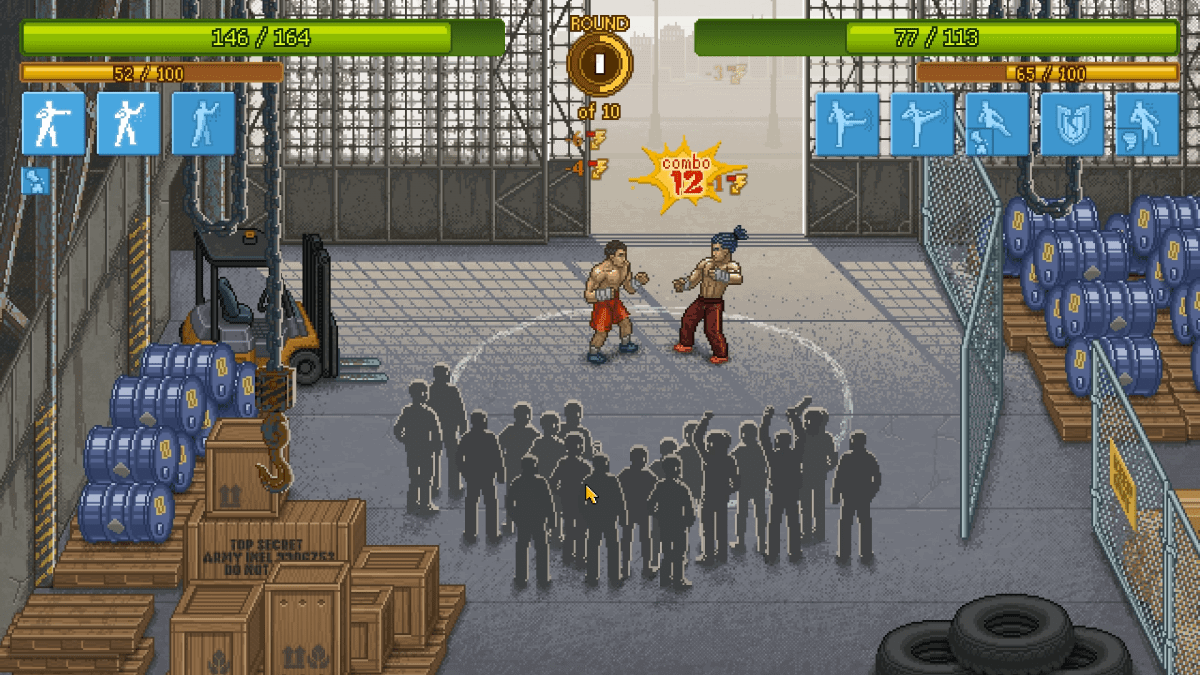Fueled by a recent “Twitch Plays” debut, Punch Club has been flying off the metaphorical shelves on steam, and with good reason. Much like other hit indie titles of today, Punch Club takes simple and somewhat familiar gameplay to offer a totally new experience; following Five Nights at Freddy’s, Undertale, and even Pony Island before it. Games of this ilk are a real testament to what can be accomplished with a little ingenuity and a creative mindset: a world and progressive story that make the player forget that the gameplay they’re experiencing is actually quite tedious and repetitive, the same basic principal that RPGs have thrived on for years.
With all that said, let’s see how Punch Club uses this principal to stand out.
Game Name: Punch Club
Platform(s): PC (Steam), IOS, Android
Publisher(s): tinyBuild
Developer(s): Lazy Bear Games
Release Date: 1/8/2016 (PC), 1/14/2016 (IOS), TBA (Android)
Price: 9.99 (PC), 4.99 (Mobile)
Reviewed on: PC
In Punch Club, you play the role of a young up-and-coming fighter who’s just trying to make it by. As it so happens, along the way he discovers that the mysterious man who killed his father has resurfaced and is holding a sort of kumite for elite fighters. Our hero must fight on through legitimate and less than reputable arenas to make his mark to try and avenge his father’s death.

Before anything else is said, let it be known that Punch Club is a tycoon-style game. This means that the core gameplay revolves around resource management and in this case the primary resources are health, food, mood, and energy, while stats, money, and time acting as secondary resources. All of these resources must be balanced carefully to ensure that the player can progress through the game, so let’s look at what they do and why they matter.
Health: Health is fairly straightforward in its purpose: it acts as a measure of how much health you have in a fight. Health is lost by participating in fights regardless of who wins, but it can be earned back by sleeping and eating.
Food: When all is said and done, a fighter needs to be well-fed. The food resource is consumed by every action except for travel: exercise, sleeping, working, and watching TV. Understandably, the food meter is replenished by eating the food you buy at the convenience store.
Mood: Mood affects the quality of your workout regimen. If your mood level is too low, you will gain stats slower when working out. Mood is drained by working, and is replenished by watching TV or sleeping; however, it’s important to note that mood regenerates very slowly, so it is never worth letting it get past the point where you get diminishing returns on workouts.
Energy: Much like food, energy is consumed for almost every action: working, exercise, and watching TV. Replenish your energy with sleep or energy drinks (though they are rather pricey for the amount of energy you get from them).
Stats: In order to become a top fighter, you have to train. In Punch Club, there are three stats: Agility, Strength, and Stamina. Agility raises your likelihood of hitting with attacks and dodging; strength makes your attacks do more damage, but makes them less accurate and more energy inefficient; and stamina increases your maximum health, defense, and energy recovery (not to be mistaken with the energy resource, this type energy dictates how many moves your fighter can make before he tires out).
Each stat is increased by a specific type of exercise, and can only be raised a certain amount before returns diminish unless you vary your workout routines.
Money: Just like in real life, money makes the world go round in Punch Club. It is needed to buy food, pay gym fees, take the bus, and buy workout equipment should you be so inclined. Naturally, you earn money by working jobs around town and winning fights. Be sure to manage your money wisely; if you find yourself with no money or food, you’ll have to restart the game.
Word to the wise: neglecting workouts to earn money and buy workout equipment to remove the need for gym fees from the equation is not a viable option. If you travel with enough money to actually purchase said equipment, there is a high chance that you will be mugged along the way and without good stats, you will lose the fight and half of your money along with it.
Time: Time wounds all heels. Every action you take consumes time: working out, sleeping, watching TV, working, and traveling (unless you choose to spend money on the bus). It’s important to track the passage of time as fights only occur on certain days, not to mention that your stats automatically go down at the end of each day. Make sure you find a good balance between working, exercising, and recovering stats with TV or sleep.

These resources are the core of this game. In fact, they are the entire game. The story progresses through winning fights and the only way to win fights is to have good stats, the only way to have good stats is to manage resources well. This is due to the automated nature of fights, as matches are practically decided within the first few seconds since the player has no actual say in how fights go down. Even though it’s the player’s choice to assign the moves that their fighter uses in his fights, they have no control over when or how often he uses them.
With that said, there is a skill tree with three branching paths based on each stat for varied combat styles as well, but unfortunately it’s poorly balanced.
The speed tree is fantastic as it offers high accuracy and evasion, meaning that fewer automated actions will go to waste.
The strength tree is decent as it offers very high damage, but it comes with low accuracy and high energy consumption, meaning a bad stroke of RNG can easily cost you a fight you should have by all means won.
Lastly, the stamina tree is simply terrible. It basically makes you a brick wall, but the special defensive attacks it offers often don’t work as intended if even at all.
Other than that, the story follows along decently, even though it’s nothing overly special; just a typical 80’s/90’s-style romp in the vain of Rocky or Double Dragon. However, it’s the visuals that steal the show.
Punch Club uses high-quality pixel art throughout, and in such, marvelously captures the spirit of the 80’s and 90’s. From the pixelated renditions of famous movie posters and characters scattered around town to the sheer detail in the characters and environment, there is little to be desired. The game’s soundtrack is similarly impressive, emulating the classic style that one might find in a quality SNES title.
*Review copy provided by tinyBuild
Kick, punch, it's all in the mind
We don't talk about Punch Club
Looking past its viral marketing campaign, Punch Club does a pretty good job at making itself stand out in the indie market space. The more concrete goal of becoming a top fighter and finding your father’s murderer proves to add more weight to the normally tedious tycoon gameplay. However, the game is not without fault: the customization in skills is quite nice in theory, but due to the unbalanced nature of the tree, speed becomes the obvious option. In addition, poor management of resources means that it is full well possible to have to wipe the slate clean and try again, which is a real pain due to the story actually being quite interesting for a tycoon game. So is Punch Club worth it? Yes, on the condition that you understand the grindy nature of what you’re in for.
Pros:
- Impressive art
- Innovative in the genre
- decent story
Cons:
- Story means you lose more with game over
- lack of balance in skill trees
-
Gameplay - 7/107/10
-
Graphics - 9/109/10
-
Sound - 8/108/10
-
Value - 6/106/10




